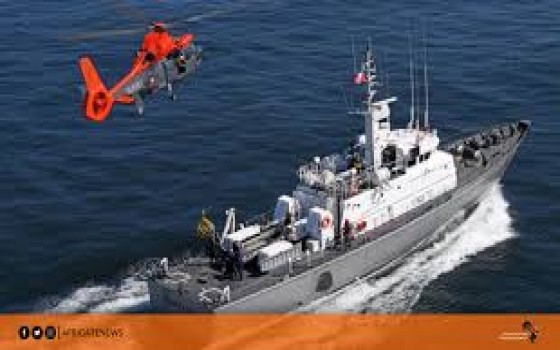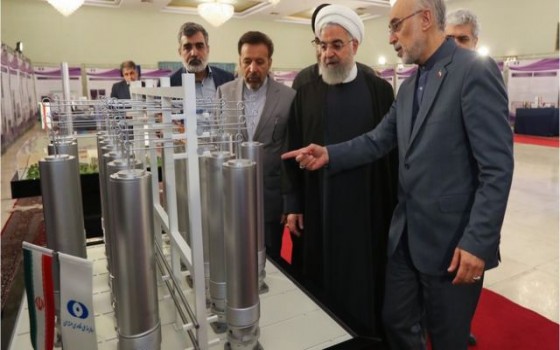
The Pentagon combines marine drones and artificial intelligence to monitor Gulf waters

- Europe and Arabs
- Saturday , 10 September 2022 14:42 PM GMT
AFP
Iran's seizure, a short time ago, of a US Navy cruiser in the Gulf, shed light on a new pioneering Pentagon program that aims to enhance its capabilities to monitor large areas with air and sea drones, as well as using artificial intelligence. This one-year program includes the use of several types of marine drones known as USVs in the waters around the Arabian Peninsula and in the Gulf to collect data and images that are then sent to centers established in the region for analysis. The program did not face any problem until the Iranian Navy attempted to seize three seven-meter Saildrone Explorer naval parades during two incidents that occurred on the night of August 29-30 and September 1st. During the first incident in the Gulf waters, an Iranian Revolutionary Guards ship was spotted pulling a march to release it later after sending an American patrol boat and a helicopter to the place. During the second incident, an Iranian destroyer confiscated two Saildrone Explorer drones in the Red Sea and carried them on board. The presence of two American warships and helicopters allowed the Iranians to persuade them to return them the next day after the cameras had been taken from them, according to what the US military confirmed. The Iranians assert that these marches were located in international sea lanes, and thus wanted to "avoid possible accidents", a narrative rejected by the US Navy. Admiral Brad Cooper, commander of the US Navy's Central Command, said Iran's actions "were unjustified and inconsistent with the conduct of a professional naval force." He added that US forces "will continue to fly, sail and move anywhere available under international law." - At sea a year ago - These naval drones carry sensors, radars and cameras and are controlled by the 59th Special Force of the Fifth Fleet, based in Bahrain. This force was formed last year to develop surveillance capabilities in this region thanks to parades and artificial intelligence. And air drones are advanced and have proven their capabilities, while the drones operating on the sea surface are new, but they are essential in the future, according to the spokesman for the Fifth Fleet, Commandant Tim Hawkins, told AFP. Since the beginning of the year, the US Navy and its regional partners have deployed such slow-going Saildrone and battery-powered Mantas T-12 boats. The Mantas T-12 is equipped with a sail, wings, sensors and several cameras. It is designed to spend an entire year at sea transmitting data via satellite. Headquartered in San Francisco, California, Saildrone operates nearly 100 walks worldwide for clients including the US Department of Defense, oceanographic institutes, meteorological services and groups studying fisheries and pollution. "After a full survey of Antarctica in 2019 and after navigating the eye of a Category 4 hurricane last year, there is no longer any marine environment in which our cruise can operate," said company spokeswoman Susan Ryan. In the Gulf, Hawkins said only that it was gathering information "to improve our monitoring of the surrounding seas and strengthen our regional deterrence". But the Iranian moves are probably the main target. Iran patrols the area and has intercepted and impounded foreign merchant ships and harassed US Navy ships in several tense confrontations in recent years. The US Navy seeks to prevent Iran from sending weapons by sea to Houthi rebels in Yemen and other groups, as well as helping to enforce sanctions against Tehran. The main goal, Hawkins said, is to take the information collected by all walks of all kinds, air, land and sea, and analyze it quickly with artificial intelligence. Artificial intelligence helps detect unusual movements in data collected by marches that may be missed by human observers. "We need artificial intelligence to monitor things that need more attention," he stressed. Hawkins said it was not clear why, a year after the program began, the Iranians suddenly decided to try to intercept some of these rallies. He stressed that the United States is doing everything in public. The program was announced last September, and in February the Fifth Fleet organized the International Naval Maneuvers 2022 with the participation of ten countries and more than 80 USV marches to test them in the Gulf. The United States chose to have the headquarters of Special Force 59 in the Gulf region, rather than other areas with less challenges. According to the US military, part of the program is based on developing tactics and rules for operating these marches, including knowing how to deal with countries like Iran that are trying to get them out of the sea. So far, the United States operates these marches with manned ships in close proximity to intervene in the event of an accident of this type. A US official asserted, "No one can take out anything from the sea bearing the flag of another country. It is the sovereign property of our country and they must return it.











No Comments Found